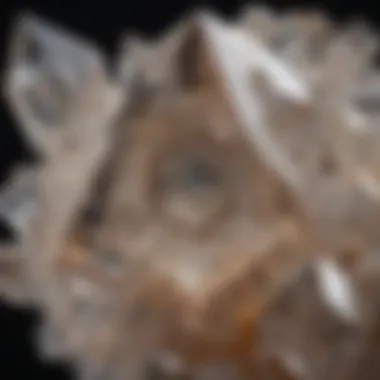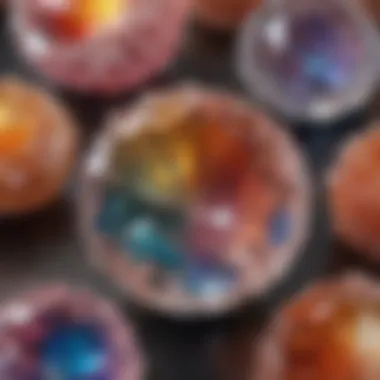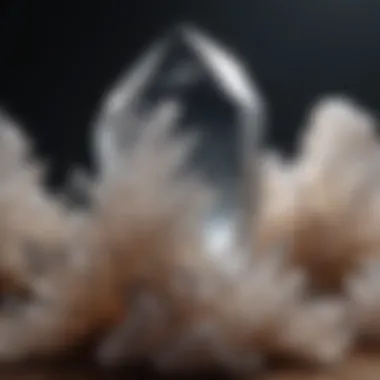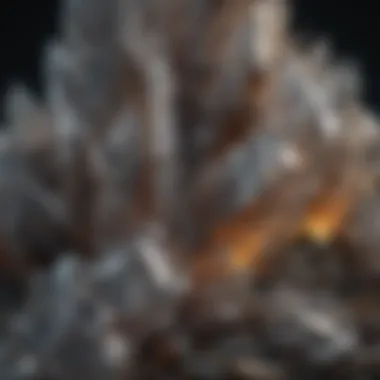Unveiling the Exquisite Visual Traits of Quartz: A Detailed Exploration


Quartz is a mesmerizing mineral that boasts a distinct visual allure, captivating enthusiasts with its exquisite beauty and versatility. In this comprehensive article, we will delve into the intriguing visual traits of quartz, shedding light on its diverse forms, stunning colors, and unique appearance.
Rock and Fossil Identification
When it comes to identifying quartz in its various forms, there are key characteristics to look out for. Quartz can be recognized by its hexagonal prismatic crystals, often transparent or translucent, with a glassy luster. Its color range spans from clear to opaque, including hues such as white, pink, purple, and smoky brown. Additionally, quartz showcases exceptional hardness, rating a 7 on the Mohs scale, making it a durable and enduring mineral.
Explorers seeking to identify quartz can make use of tools such as a hardness test kit, which allows for determining the mineral's resistance to scratching. Furthermore, a magnifying loupe can aid in inspecting quartz's crystal structure and identifying any inclusions or impurities present within the specimen. Understanding these rock and fossil identification techniques is fundamental for enthusiasts eager to distinguish quartz in its various manifestations.
Collecting Tips and Techniques
For those interested in collecting quartz specimens, adhering to best practices is essential. When exploring prime collecting sites, quartz enthusiasts should consider locations known for yielding high-quality specimens, such as quartz veins in granite or pegmatite rocks. Safety precautions should be paramount during specimen extraction, with tools like rock hammers and chisels employed carefully to avoid damaging the mineral or causing injury.
To safeguard collected quartz samples, storing them in protective cases or padded boxes can prevent scratches or breakage. Implementing proper labeling with details on the location and date of collection enhances the value and documentation of each specimen. These collecting tips and techniques ensure a responsible and rewarding experience for quartz enthusiasts venturing into the world of mineral specimen acquisition.
Preservation and Display
Preserving quartz specimens requires attention to detail to maintain their natural beauty and integrity. Techniques such as sealing with a clear varnish or resin can prevent deterioration and enhance the visual appeal of the mineral. Proper storage methods, such as placing quartz specimens in temperature-controlled environments away from direct sunlight, help preserve their color and clarity over time.
When it comes to creative display ideas, showcasing quartz specimens in shadow boxes or floating frames can accentuate their unique characteristics and provide an artistic touch to room decor. Utilizing LED lighting to enhance the mineral's sparkle or positioning specimens against contrasting backgrounds can elevate the visual impact of a quartz display. These preservation and display techniques allow collectors to showcase their quartz treasures in a captivating and aesthetically pleasing manner.
Geological Insights
Delving into the geological insights of quartz unveils its fascinating origins and historical significance. Quartz is commonly found in igneous and metamorphic rock formations, forming through the crystallization of silica-rich fluids under high pressures and temperatures. The mineral's presence throughout Earth's history showcases its enduring nature and contribution to geological processes.
Exploring notable discoveries in the field of quartz research reveals breakthroughs in understanding the mineral's properties and interactions with its environment. From ancient civilizations utilizing quartz in rituals and ceremonies to modern technological applications in electronics and optics, the historical significance of quartz spans a wide spectrum of human advancement and cultural relevance. These geological insights offer a profound appreciation for quartz's intrinsic beauty and scientific complexity, enriching the exploration of this captivating mineral.
Introduction
In the realm of geology and mineralogy, the exploration of quartz stands as a captivating journey into the visual allure and scientific significance of this remarkable mineral. This article aims to unravel the distinct characteristics of quartz, shedding light on its aesthetic diversity and structural properties that make it a perennial favorite among rock and fossil collectors and enthusiasts alike. By delving deeper into the visual aspects of quartz, we can unravel a world of beauty and complexity that lies within its crystal structures.
Overview of Quartz
Composition and Properties
The compelling allure of quartz lies in its unique composition and properties. Comprised of silicon and oxygen atoms arranged in a tetrahedral crystalline structure, quartz exhibits exceptional hardness and durability, making it an ideal choice for a multitude of geological formations. Its chemical purity and resistance to weathering underscore its resilience in various environments, cementing its status as a cornerstone mineral in geology. The key characteristic of quartz's composition is its hexagonal crystal system, showcasing symmetrical prisms and pyramidal terminations that define its visual appeal. This structural integrity not only adds to its aesthetic charm but also enhances its utility in geological studies and classification. The unique feature of quartz lies in its ability to showcase a wide range of colors and inclusions, reflecting its diverse formation processes and geological history.


Significance in Geology
Quartz's significance in geology extends beyond its visual allure to its fundamental role in understanding Earth's history and geological processes. As one of the most abundant minerals in the Earth's crust, quartz serves as a reliable indicator of geological environments and mineral associations. Its presence in igneous, sedimentary, and metamorphic rocks offers valuable insights into the conditions under which these rocks formed, providing vital clues for geologists and researchers. The key characteristic of quartz in geology is its resistance to chemical weathering and its ability to serve as a temperature and pressure indicator in metamorphic rocks. This resilience makes quartz a pivotal mineral in determining the geological evolution of an area and unraveling the complex interactions between rocks and minerals. Its unique feature lies in its ability to form associations with a wide range of minerals, creating diverse geological formations that showcase the dynamic nature of Earth's crust.
Importance of Visual Identification
Use in Identification and Classification
Visual identification of quartz plays a critical role in geological studies and mineral classification. The distinct features of quartz, including its color variations, crystal structures, and inclusions, serve as valuable markers for identifying different quartz types and formations. By analyzing the visual characteristics of quartz specimens, geologists can determine their origin, geological history, and potential mineral associations, aiding in the accurate classification of rocks and minerals. The key characteristic of visual identification lies in its ability to provide vital clues about the formation processes and environmental conditions under which quartz crystals developed. This visual data not only enhances the accuracy of geological studies but also enriches our understanding of Earth's geological history through the lens of quartz's unique properties.
Distinctive Features
The distinctive features of quartz captivate the discerning eye and provide a wealth of information for geological enthusiasts. From clear and transparent quartz to milky, smoky, rose, citrine, and amethyst varieties, each type of quartz showcases a spectrum of colors and visual motifs that reflect its distinct formation processes and mineral compositions. The key characteristic of quartz's distinctive features is its ability to form a wide array of crystal habits and color variations, illustrating the diverse conditions under which quartz crystals grew. This visual richness not only adds to the aesthetic appeal of quartz but also serves as valuable data for identifying different quartz types and understanding their geological significance. The unique feature of quartz's distinctive features lies in the intricate patterns of inclusions, veils, and phantoms that adorn its crystal structures, offering a glimpse into its geological past and formation history.
Physical Characteristics
In this segment of the article, we delve deep into the fundamental importance of understanding the physical characteristics of quartz. By focusing on the specific elements and features that define quartz visually, we not only enhance our appreciation for this mineral but also gain valuable insights into its geological significance. The examination of physical characteristics serves as a crucial foundation for rock and fossil collectors, as it aids in the identification and classification of quartz specimens. By highlighting the textures, structures, and external attributes of quartz, collectors can differentiate between various types and better comprehend the formation processes involved.
Color Variations
Clear and Transparent Quartz
Clear and Transparent Quartz stands out as one of the most visually striking forms of this mineral. Its pristine clarity and glass-like appearance make it a popular choice among collectors and enthusiasts seeking purity and elegance in their specimens. The key characteristic of Clear and Transparent Quartz lies in its ability to reflect and refract light with exceptional brilliance, giving it a captivating sparkle. This clarity not only showcases the internal structures of the quartz crystal but also allows for a better appreciation of any inclusions or unique features present. While the lack of coloration in Clear Quartz may be perceived as a disadvantage in terms of variety, its purity enhances the beauty and versatility of this quartz type.
Milky Quartz
Milky Quartz, distinguished by its milky white hue and opaque quality, offers a stark contrast to the transparent varieties. The key characteristic of Milky Quartz is its cloudy or whitish appearance, caused by the presence of microscopic fluid inclusions within the crystal lattice. This distinctive feature gives Milky Quartz a soft, diffuse glow that sets it apart from its transparent counterparts. Collectors often appreciate Milky Quartz for its ethereal charm and the way it diffuses light, creating a serene and gentle aesthetic. While the lack of absolute transparency may be considered a drawback by some, the milky appearance adds a unique allure and texture to Milky Quartz specimens.
Smoky Quartz
Smoky Quartz, named for its smoky brown to black coloration, exudes a mysterious and earthy vibe that attracts collectors seeking a sense of depth and grounding in their quartz specimens. The key characteristic of Smoky Quartz lies in its dark translucency, which results from natural irradiation of the crystal during its formation process. This rich hue gives Smoky Quartz a sense of rugged beauty and ancient mystique, making it a prized addition to any collection. While the dark color may limit the play of light within the crystal, it adds a distinctive warmth and intensity that appeals to those drawn to its enigmatic charm.
Rose Quartz
Rose Quartz, known for its delicate pink hues ranging from pale pastels to vibrant blush tones, embodies a sense of love, compassion, and emotional healing. The key characteristic of Rose Quartz is its gentle color saturation, which evokes feelings of tenderness and warmth. This soothing appearance makes Rose Quartz a popular choice for collectors interested in the metaphysical properties and emotional resonance of gemstones. The subtle translucency of Rose Quartz allows light to filter through the crystal, creating a soft glow that symbolizes love and inner peace. While the color range in Rose Quartz may be limited compared to other varieties, its essence of love and harmony makes it a cherished and meaningful addition to any collection.


Citrine Quartz
Citrine Quartz, with its warm golden to yellow hues reminiscent of sunlight, radiates positivity, abundance, and joy. The key characteristic of Citrine Quartz is its sunny color palette, which brightens any collection and brings a sense of optimism and vitality. This vibrant gemstone is prized for its energizing properties and ability to dispel negative energies, making it a popular choice for those seeking clarity and inspiration. The transparent nature of Citrine Quartz allows light to pass through the crystal, enhancing its luminosity and brilliance. While Citrine Quartz may have a more limited color range compared to other quartz varieties, its sunny disposition and metabolic effect make it a coveted addition to crystal collections.
Amethyst Quartz
Amethyst Quartz, revered for its regal purple hues varying from light lavender to deep violet, exudes a sense of spiritual connection, intuition, and tranquility. The key characteristic of Amethyst Quartz is its royal purple color, symbolizing wisdom, power, and luxury. This majestic gemstone is highly sought after for its metaphysical properties and calming influence on the mind. The rich color saturation of Amethyst Quartz creates a sense of depth and mystery, inviting collectors into a world of spiritual resonance and inner reflection. While the color range in Amethyst Quartz is limited to shades of purple, its association with spiritual growth and mental clarity makes it a valuable and captivating addition to any crystal assortment.
Crystal Structure
Hexagonal Prisms
In the realm of crystallography, Hexagonal Prisms represent a distinctive form of structural arrangement found in quartz crystals. The key characteristic of Hexagonal Prisms lies in their six-sided symmetry, with flat faces forming a hexagonal cross-section along the crystal's length. This geometric precision results in a uniform and elegant appearance, enhancing the visual appeal of quartz specimens. The geometric regularity of Hexagonal Prisms not only contributes to the aesthetic beauty of quartz crystals but also plays a crucial role in their growth and internal atomic arrangement. Collectors admire the clean lines and symmetry of Hexagonal Prisms, appreciating the inherent order and balance found in these crystals.
Pyramidal Terminations
Pyramidal Terminations, featuring pointed ends resembling pyramids, represent a striking facet of quartz crystal structures. The key characteristic of Pyramidal Terminations is their sharp, pyramid-like shape at the ends of the crystals, adding a dynamic and eye-catching element to quartz specimens. These terminations create a sense of directionality and energy flow, drawing the eye towards the apex of the crystal. The geometric complexity of Pyramidal Terminations showcases the natural growth patterns and symmetry present in quartz crystals, providing collectors with a visually engaging feature to admire. While the pointed terminations may exhibit some fragility, their geometric allure and symbolic significance make them a desirable and intriguing aspect of quartz crystal formations.
Surface Features
In the realm of quartz exploration and identification, the facet of Surface Features plays a pivotal role. Understanding and recognizing these surface characteristics not only aids in differentiating various types of quartz but also provides valuable insights into the mineral's formation history and geological significance. By delving into the nuances of Surface Features, enthusiasts and researchers alike can build a holistic comprehension of quartz specimens.
Surface Features in quartz encompass a spectrum of attributes, from luster and transparency to inclusions and imperfections. These traits act as clues to the mineral's journey, revealing information about its crystallization process, environmental conditions, and interactions within its geological surroundings. Consequently, a thorough examination of Surface Features serves as a gateway to uncovering the captivating story that each quartz formation encapsulates.
Luster and Transparency
Vitreous Luster
Vitreous Luster, a hallmark attribute of many quartz varieties, refers to the mineral's glass-like sheen when exposed to light. This characteristic imparts a dazzling shine to the surface of quartz specimens, enhancing their aesthetic appeal and making them stand out in collections and displays. The reflective quality of Vitreous Luster not only elevates the visual allure of quartz but also aids in distinguishing it from other minerals with differing luster properties.
The key allure of Vitreous Luster lies in its ability to refract and reflect light, creating a mesmerizing play of colors and brightness. This feature not only accentuates the inherent beauty of quartz but also underscores its unique optical properties, making it a sought-after choice for adornments, jewelry, and decorative items. While Vitreous Luster enhances the overall visual impact of quartz specimens, it also serves as a practical indicator for gemologists and collectors, signifying the mineral's quality and desirability.
Transparency Levels
Transparency Levels in quartz dictate the degree to which light can pass through the mineral, ranging from transparent to opaque. This attribute influences the visual clarity and translucency of quartz specimens, impacting their allure and value in the eyes of collectors and enthusiasts. The varying transparency levels of quartz not only add depth and dimension to its appearance but also hint at the mineral's purity, structural integrity, and internal composition.


The key characteristic of Transparency Levels lies in their role as a window into the inner world of quartz, revealing intricate internal structures and features that contribute to its visual charm. Transparent quartz varieties showcase pristine clarity and light transmission, reminiscent of crystalline waters and pure substances. In contrast, opaque specimens evoke a sense of mystery and depth, showcasing unique patterns and textures that add character to each piece. Understanding and appreciating the different Transparency Levels in quartz enables collectors to discern the quality, rarity, and appeal of individual specimens, enriching their exploration and appreciation of this versatile mineral.
Inclusions and Imperfections
Veils and Phantoms
Veils and Phantoms, distinctive inclusions found in quartz, hold a special allure for collectors and researchers due to their enchanting visual effects and symbolic significance. These ethereal formations within quartz crystals provide a glimpse into the mineral's growth history, capturing moments of fluidity and interruption in the crystallization process. Veils manifest as wispy, translucent streaks that intersect the crystal lattice, creating a mesmerizing play of light and shadow, while Phantoms denote crystal growth interruptions that result in ghostly outlines or shapes within the quartz structure.
The key allure of Veils and Phantoms lies in their ability to transform quartz specimens into artistic masterpieces, blending natural beauty with geological intrigue. Their presence not only adds aesthetic value to the crystals but also serves as a visual testament to the dynamic forces that shape the mineral world. Veils and Phantoms offer a window into the intricate journey of quartz formation, reflecting the interplay of time, pressure, and mineral solutions that result in these mesmerizing patterns and textures.
Needle-Like Inclusions
Needle-Like Inclusions, slender crystals or mineral fragments embedded within quartz structures, contribute to the mineral's visual allure and scientific significance. These delicate formations add a touch of elegance and sophistication to quartz specimens, hinting at the mineral's geological origins and formation conditions. Needle-Like Inclusions range in color, shape, and size, creating captivating patterns and textures that enhance the overall charm of quartz crystals.
The key characteristic of Needle-Like Inclusions lies in their ability to embellish quartz specimens with intricate details and unique features, elevating their aesthetic appeal and collector value. These inclusions serve as miniature works of art within the quartz matrix, highlighting the mineral's diversity and complexity. While Needle-Like Inclusions add visual interest to quartz crystals, they also offer valuable insights into the mineral's geological context, enriching the storytelling aspect of each specimen and inspiring further exploration and appreciation.
Specific Geological Formations
In the exploration of quartz characteristics, understanding specific geological formations plays a crucial role in unraveling the complexities of this mesmerizing mineral. By delving into the geological formations where quartz thrives, we gain invaluable insights into its origins, growth patterns, and distinctive attributes that make it a coveted mineral among rock and fossil collectors.
Veins and Geodes
Quartz Veins in Host Rock
Exploring quartz veins in host rocks reveals a fascinating aspect of quartz formation. These veins, which serve as conduits for mineral-rich fluids, intricately weave through surrounding rocks, leaving behind a trail of quartz deposits embedded within. Such veins, characterized by their distinct colorations and crystalline structures, offer a window into the geological processes that have shaped the Earth's crust over millennia. Their presence not only signifies the presence of quartz but also hints at the dynamic geological forces at play beneath the surface.
Geodes with Quartz Crystals
Geodes featuring quartz crystals present a captivating spectacle for collectors and enthusiasts alike. These spherical rock cavities, lined with a myriad of quartz crystals in varying colors and forms, showcase the beauty and diversity of quartz in a unique setting. The formation of geodes, typically found in volcanic or sedimentary rocks, offers a glimpse into the intricate interplay between mineral-rich solutions and cavity formation processes over time. Collectors are drawn to geodes not only for their aesthetic appeal but also for the geological stories they hold within their crystalline confines.
Conclusion
In the vast realm of quartz exploration, the conclusion serves as a pivotal juncture where the culmination of visual characteristics and geological significances converge. Understanding the visual appearance of quartz extends beyond mere aesthetics; it delves into the core identity of this mineral and its implications in various fields. By appreciating the spectrum of colors, crystal structures, and surface features, enthusiasts and researchers tap into a wellspring of knowledge that extends far beyond the physical realm. The importance of the conclusion lies in synthesizing the intricate details explored throughout the article, offering a comprehensive insight into the essence of quartz and its significance in geology, classification, and identification.
Appreciating the Diversity of Quartz
Beauty in Variation
Within the realm of quartz exploration, the concept of "Beauty in Variation" emerges as a striking facet that embodies the essence of individuality and uniqueness within quartz formations. This pivotal aspect celebrates the diverse colors, formations, and structural intricacies that define each specimen, adding a layer of complexity and allure to quartz appreciation. The key characteristic of Beauty in Variation lies in the ability to captivate enthusiasts across diverse backgrounds, from seasoned collectors to novices seeking to unravel the mysteries of the natural world. This intrinsic quality serves as a driving force behind the enduring appeal of quartz in the geological and aesthetic spheres, offering a rich tapestry of visual delights that never fail to intrigue and inspire. While Beauty in Variation enriches the discourse on quartz characteristics, it also presents challenges in terms of identifying and categorizing specimens due to their unique and often unpredictable nature.
Symbolism and Cultural Significance
In the multifaceted world of quartz exploration, the realm of Symbolism and Cultural Significance emerges as a profound domain that transcends the boundaries of science and enters the realm of human expression. This intricate aspect unearths the deep-rooted meanings and associations that various cultures have attributed to quartz throughout history, from ancient civilizations to modern societies. The key characteristic of Symbolism and Cultural Significance lies in its ability to bridge the gap between the material and the spiritual, offering a gateway to understanding the cultural contexts in which quartz holds sacred or symbolic value. This facet enriches the exploration of quartz characteristics by shedding light on the interconnectedness of humanity and nature, where the mineral world intertwines with human narratives and beliefs. While Symbolism and Cultural Significance add layers of depth and intrigue to the study of quartz, they also present challenges in interpreting and contextualizing the myriad interpretations and beliefs associated with this versatile mineral.







